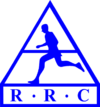Road Runners Club (UK)
| Motto | Representing Road Runners Nationwide |
|---|---|
| Formation | 14 June 1952 |
Membership | Approx 1,000 (as at 2011) |
| Website | http://www.roadrunnersclub.org.uk |
The Road Runners Club is an association of road runners formed in 1952 to encourage the athletic discipline of road running in the United Kingdom.

History
The RRC was founded under the leadership of Ernest Neville (1883–1972) as a result of the success of the London to Brighton road running race he had organised, and which took place on August 11, 1951 as part of the Festival of Britain celebrations.[1] Ernest had a lot of previous experience of organising Road 'Walking' races from London to Brighton and was just as passionate about 'Road Running'.
The second London to Brighton Race was staged in 1952 and became an annual event until 2005 when organisational difficulties prevented its continuation on public roads. The exact distance varied over the years from 52 miles 694 yards to 55 miles due to road and course changes. Its "sister" race, the Comrades of South Africa, held over a similar distance, pre-dates RRC London to Brighton race,(first race 1921) and continues to this day (2011).
The main trophies at the London to Brighton race were the Arthur Newton trophy (named after another RRC founding member) for the winner and, for the first winning team, the "Len Hurst" belt (which had previously been won by the well-known pedestrian runner of the late 19th and early 20th Century), donated by his wife to the RRC.
In addition to the London to Brighton race the RRC has organised and sponsored various long distance track races when numerous records were set. These included 24 hour and 50 mile track races.[1] Amongst the 100 mile track races were the following:
- 100 mile track World Best (11:38:54)[2] - Cavin Woodward, October 1975, Tipton near Birmingham
- 100 mile track World Best (11:30:51)[3] - Don Ritchie, October 1977, Crystal Palace, London
- 100 mile track World Best (11:28:03)[3] - Oleg Kharitanov, October 2002, Crystal Palace, London
The club's success resulted in similar organisations being established elsewhere in the world, in particular the Road Runners Club of America, and RRCs in India, Korea, New Zealand and South Africa.
The club's badge was designed by a Harold Murrells and is based on the symbol for the Greek element air.[1]
The RRC was important in developing accurate course measurement and procedures for the correct organisation of long distance Road and Track races. Both were pioneered by the late John Jewell. He is still acknowledged as a leading pioneer in this field by certified course measurers around the world. The race procedures he formulated are still also the basics with which races are organised world wide.[4]
John Jewell also initiated a "Standards Scheme" whereby members are awarded certificates for achieving set times over a range of distances. Over the years the scheme has been extended to include times for women and for Masters.
Structure
The club's constitution states that the management of the club be vested in a council whose members are:
- President
- Past Presidents
- Up to 30 Vice-Presidents
- Honorary General Secretary
- Honorary Treasurer
- and up to 30 other members
Past Presidents
| President | First Claim Club | Term in Office |
|---|---|---|
| Rex Cross | Blackheath Harriers | 1952–1953 |
| Sam Ferris | Polytechnic Harriers | 1954 |
| Jim Peters | Essex Beagles | 1955–1956 |
| John Jewell | South London Harriers | 1957–1958 |
| Lew Piper | Blackheath Harriers | 1959 |
| Vic Fowle | Herne Hill Harriers | 1960–1961 |
| Tom Richards | South London Harriers | 1962–1963 |
| Ernest Neville | Blackheath Harriers | 1964 |
| Arthur Bourne | Liverpool Pembroke AC | 1965–1966 |
| Gordon Doubleday | Belgrave Harriers | 1967–1969 |
| Bernard Baldwin | Mountain Ash | 1970 |
| Mervyn Dunaway | Stock Exchange AC | 1971–1972 |
| Harold Lee | Orion Harriers | 1973–1975 |
| Brian Doughty | Manchester AC | 1976–1977 |
| Don Turner | Epsom and Ewell Harriers | 1978–1979 |
| Bob Pape | Royal Navy | 1980–1981 |
| Peter Goodsell | Walton AC | 1982–1984 |
| John Dixon | Epsom and Ewell Harriers | 1985–1986 |
| Ron Hill | Clayton-le-Moors Harriers | 1987–1988 |
| Alan Storey | Ranelagh Harriers | 1989–1990 |
| Ian Macintosh | City of Bath AC | 1991–1992 |
| John Gebbels | Herne Hill Harriers | 1993–1994 |
| Hilary Walker | Serpentine RC | 1995–1997 |
| Stephen Moore | Hertford and Ware AC | 1998–2000 |
| Don Ritchie MBE | Forres AC | 2001–2003 |
| David Bedford | Shaftesbury Harriers | 2003–2006 |
| Hugh Jones | Ranelagh Harriers | 2007–2011 |
| Ian Champion | RRC | 2011— |
Membership
Originally, only those (men) who were already members of running clubs affiliated to the National Governing Body of their own country were eligible to join the RRC (overseas members being allowed). Since the 1980s membership has been open to all men and women. There are currently (2011) nearly 1,000 members.
Publications
- Roadrunner Magazine. Published three times per year.
- Training For Ultras (1987, Various international level contributors, Edited by Andy Milroy) Out of Print as at Feb 2011.